1521: the fall of Szabács, Zimony, and Nándorfehérvár castles
These forts were the gates of Hungary, King Matthias Corvinus used to say that in case of losing them, nothing could stop the Ottoman Turks to invade the whole kingdom. Thirty-one years after his death, these castles were lost and the road to Mohács was paved. However, we should pay tribute to the fallen heroes who tried to defend these forts until their last breath: let us tell their story and learn the names of Heroes: Logodi Simon, Thorma András, and Oláh Balázs. (Note, I use the Oriental name order for Hungarians where family names come first.)
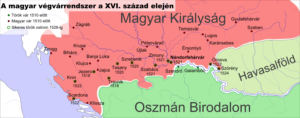
Many important forts of Hungary’s southern Borderland were seized during the great campaign of Sultan Suleiman in 1521, fortresses like Szabács (Шабац / Šabac), Zimony (Земун / Zemun), and Nándorfehérvár (Belgrade). Suleiman’s army was so big that it enabled him to lay siege to two important castles at the same time.

Before the siege of Szabács
While the Anatolian army besieged Nándorfehérvár (Belgrade), the Rumelian army went to besiege Szabács castle: there were only a couple of hundred Hungarian and Serbian defenders while the Rumelian Begler-Bey, Ahmed, had 25,000 men. Most of them were soldiers from the Balkans and just a small part of them were Turks.

Since the Sulyok brothers did not return to Szabács from Buda, the defense of this very poorly equipped fortress was left to the sub-captains Logody Simon and Torma Endre. According to one version, the castle’s guard consisted of about 500 soldiers, according to another only 100 riflemen. According to the habit of the Valiant Order of the Hungarian Borderland, there were two captains in the castle, Bán (Duke) Logodi Simon, and Bán Torma Endre decided to fight until the last man and they made their soldiers swear the same oath.

There was a great shortage of guns; none of the larger calibers were available; ammunition and food were also in short supply. Towards the end of June, when the Turkish advance troops, the Akindsis, arrived under Szabács and began to surround the castle, Logody immediately called for help from Buda, but the small army sent by the Diet did not arrive at its destination in time.
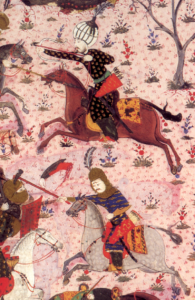
In fact, it is said that the court at Buda was informed of the great danger threatening the country only in mid-June, when Suleiman’s army, with the bulk of its forces, was known to have reached the Sofia area, and only then did the members of the royal council become aware of the great danger. The king then proclaimed a general assembly in Buda at the end of June, according to the resolution of which he declared a public uprising by carrying the bloody sword around it, and at the same time issued an order to the lords and counties to lead their troops without delay to the camp of Palatine Báthory István in Zenta, or to Tolna, where he himself would appear.

To cover the costs of the war preparations, the Diet drew money from various sources, including the seizure of the estate of Archbishop Bakócz Tamás, who died on 16 June, and loans from various places, etc. At the same time, King Lajos (Louis) urged the Pope, the German Emperor, Doge Loredano, and all Christian princes not to delay their support, because the Turks were threatening not only Hungary but also the whole of Christendom.

King Lajos also called on the Bohemians, Moravians, and Silesians to provide similar urgent aid, warning them not to abandon their king and neighbors in times of great need and danger. And it may be noted at this point that the foreign princes did give some help at this time; but, as it came too late, it could not be used. Archduke Ferdinand gave 3,000 men, King Sigismund of Poland 2,000 infantry and 500 horsemen, Silesia also sent a small army, but only in September, and Venice sent 24,000 gold pieces.

Most humiliating of all were the Czechs, who completely ignored the king and who, despite King Lajos’ prohibition, sent their mercenaries to the camp of King Francis of France against Emperor Charles V, who offered them a larger ransom than King Lajos could have. Let us not forget that King Lajos was not just a Hungarian king but also the king of Bohemia.

Finally, the question of the main commander was raised. The court party did not want to hear anything about Szapolyai, who otherwise did not appear at the meeting and who was considered the best commander since the defeat of the Peasant Uprising of Dózsa György in 1514. In fact, by virtue of his position and office, Palatine Báthory István would have been called upon to take over the supreme command, but the majority of the lords did not trust the old man, who was a man of many dwindling years, and considering that he had only recently married, he did not show much inclination to take on the onerous office either.

So Tomori Pál was offered the post of commander-in-chief, but he had not received the Auranean priory he had so recently demanded, he sullenly refused the post, declaring that, in accordance with his monastic vows, he wished to spend the rest of his days in seclusion from the world. As a result, King Lajos at last entrusted the general command to the Palatine, who accepted it without hesitation.

After the meeting, the king appointed the brother of the Palatine, Báthory Endre, captain of the fleet, and made it his duty to gather the scattered boatmen and rush with them under Nándorfehérvár (Belgrad). Báthory Endre started from Buda with three ships, which were supplied by the cities with 600 infantrymen and after a few days he landed at Erdőd, but he did not succeed in gathering the boatmen and so he was stranded there idly until the end of the campaign.

The heroic siege of Szabács
The siege began on 20 June. The attacks of the Akindsis were repulsed without much difficulty by Logody and his companions, but when on 4 July the army of Achmed Pasha arrived and began to shell the castle, the situation soon became untenable. By 5 July the outer castle was so damaged that it had already fallen to the Turks, and the heroic resistance of the meager garrison could not prevent the enemy, who were vastly outnumbered, from pushing in through the gaping gaps.
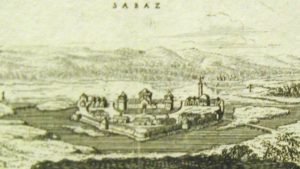
The defenders got stuck into the inner castle and during the bloody fight, their number was reduced to 70. In the end, they have run out of all their gunpowder, and their cannons and guns became silent. They could have escaped towards the Száva River but they chose to make a heroic last stand.

On 6 July, the Turks filled the moats of the castle with brushwood and prepared for a decisive assault. On 7 July, the Janissaries were already climbing the walls of the inner castle, which the garrison could not prevent, only because they had run out of gunpowder. Even now, the remnants of the garrison could have easily escaped across the Száva, but, true to their oaths, they held on to their last breath on the field of honor.
So when the enemy was already advancing on the walls from all sides, the guard, reduced to 60 men, gathered in the marketplace of the castle and there awaited the last assault of a large number of the enemy, and then all these lion-hearted champions of the Homeland, who fell one by one, but not without revenge, for beside them lay the corpses of 700 Janissaries. The total number of casualties suffered under Sabács was estimated by the Turks themselves at several thousand.

Achmed Pasha, ashamed that he had failed to capture a single prisoner, reported to Sultan Suleiman, who arrived the next day, 8 July, that most of the defenders had escaped across the Száva River, but to please his mighty lord, he had the skulls of the heroic defenders impaled in a row along the road leading to the castle.

The Rumelian Army had suffered great losses during the siege of Szabács. We can see similar examples of self-sacrifice in the cases of Drégely and Szigetvár Castle only later in 1552 and 1566. After the fall of Szabács, the Rumelian army joined the Anatolian army at Nándorfehérvár. You can read more about the history of Szabács here:
https://www.hungarianottomanwars.com/ottoman-occupied-lands/szabacs/
The Sultan fortified the castle even further by digging strong fortifications and moats, and immediately ordered a bridge to be built on the Száva River. This was done so that, if the Hungarians attempted to relieve Nándorfehérvár (Belgrad), which was still under siege, he and the Szabács could stand in the way of the relieving army in the Szerémség (Sirmium) Region. When this bridge was completed on 19 July, it was so badly damaged by the floods that day that it took another eight days to repair it.
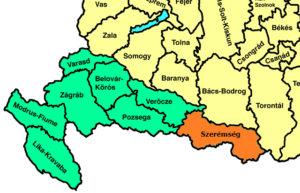
Finally, on 27 July, the bridge, 1,800 yards long, was ready for the army to begin its crossing of the river. In the meantime, small troops, which had been transferred by boat to the Szerémség under the command of Bey Báli, captured Kölpény and some other small forts and returned to Szabács with a rich booty, 60 severed heads, and several prisoners.
After the siege of Szabács
In the meantime, Báthory István, under orders from the king, assembled his army at Zenta, crossed the Danube at Pétervárad, and entered the Szerémség, but after the completion of the bridge at Száva, the Turk army became increasingly larger, allegedly 17. 000 men.

Palatine Báthory, who was already ill, after having suppressed a small Turkish army at Száva-Szent-Demeter, turned back with all his forces and at Pétervárad (Petrovarad), crossing again to the left bank of the Danube, remained, so to speak, an idle spectator of the fierce struggle that had been raging for a long time at Nándorfehérvár. However, the raiding troops of Bey Báli, catching sight of the retreat of the Palatine, again pushed forward offensively in the Szerémség, where they robbed, ravaged, and burned Száva-Szent-Demeter, Karlóca, Ujlak, Barics, Perkász, and Zalánkemén.

Hearing the bad news about the fall of Szabács, and having waited in vain for foreign help, King Lajos also set out for his camp in Tolna on 15 July, but his whole band consisted of only 200 horsemen. According to a note from the Venetian envoy’s secretary, before setting out the king said that he wanted to see which lords would follow him. But the secretary continues, “No one will follow him, for there is great strife among them, and the serfs are filled with great hatred against their lords, and the country is on the verge of a whirlpool.”

On the way, King Lajos settled for a longer period in Tétény, then returned to Buda, from where he set out for a second time on 8 August with some Polish, Czech, and German troops, which had arrived in the meantime, but still did not exceed 4,000, including the Hungarian battalions.

On 11 August the king was in Érd, and on 16 August in Adony, when his army numbered 6,000, and here he received the news that Suleiman had already taken the city of Nándorfehérvár and that the guards had retreated to the castle.

Thereupon, he sent orders at once to Palatine Báthory to march from Zenta to Szerémség with his army. At the same time, Szapolyai János, the Transylvanian voivode, who was approaching with his army from Transylvania through the valley of the Maros (Mures) River, and the lords were called upon to hurry to Bács with their bands and the counties to send their troops there to join the king’s army, which was also hurrying to Bács.

The Palatine obeyed and set out from Zenta. He arrived at Futak, where he loaded 3 galleys with cannons, gunpowder, bullets, and foodstuffs to send them to Nándorfehérvár, but as the Turkish fleet was on guard at Zalánkemén, the intended expedition to the Danube failed. At Futak, with the army of the Palatine, which in the meantime had increased to about 18,000 with the battalions of the Temes (Timis) region and the noblemen from Bács County, he waited for the Voivode for a while, then, having learned that Szapolyai’s arrival could not be expected soon, he crossed the Danube, marched into the Szerémség region, but from there, as we know, he soon returned to the left bank of the Danube.

In the meantime, the royal army, continuing its march from Adony on 18 August, arrived in Tolna on 22 August, where a band of several high priests and lords and a few thousand Czech and German mercenaries had gathered. At Tolna, the royal army, which had meanwhile increased to 20,000, was still stranded for more than two weeks.

At the same time, Voivode Szapolyai János of Transylvania was camped at Lippa Castle with about 20,000 troops. Before that, he had been busy in Transylvania and Wallachia. Bey Mohammed Michaloghli, having reached Wallachia, seized power there completely and, taking control of the seven-year-old son of the deceased Wallachian voivode, sent him to Constantinople.

The Wallachian (Romanian) boyars then chose a former priest named Radul as their prince, but the Turkish leader defeated him at Tirgovits and declared the whole of Wallachia a Turkish province. The Wallachians then elected a relative of Bazaraba, also called Radul, as their voivode, who first fought the Turks with luck at Glubavi and Closani in the Motru valley, but in the third battle that followed he was defeated and then turned to Szapolyai for help.

With the Hungarian troops that had arrived, Radul was victorious in a battle fought from morning till night near Grumac, but after being beaten, he was forced to retreat to Transylvania, from where Szapolyai, at the repeated urgings of the king and the government, had withdrawn with the bulk of his army, about 20,000 men, through the valley of the Maros to Hungary, where he arrived in mid-August.
The fall of Zimony, and Nándorfehérvár
Oláh Balázs used to be the one who held the defense of Nándorfehérvár (Belgrade) in his hands during the siege in 1521 because the two Báns (Dukes) Héderváry Ferenc and the child Török Bálint had left the fort. As a result of this, the task of the defense went to the two vice-Báns, Oláh Balázs and Móré Mihály.

Grand Vizier Pasha Piri Mehmed arrived at Nándorfehérvár at the beginning of July but the real siege began in earnest only after the taking of Szabács Castle in the middle of the month. By the end of July, Sultan Suleiman has also arrived from Szabács (Sabac) castle. Nándorfehérvár castle has been surrounded by all sides by this time. You can read the history of Nándorfehérvár / Belgrade here:
https://www.hungarianottomanwars.com/ottoman-occupied-lands/nandorfehervar/
The number of the defenders was 700 men and the Hungarians were supported by the Serbian inhabitants of the city, along with a unit of boaters on the Danube River. Unfortunately, they did not have enough gunpowder, artillery, or food in the fort. They could hope for only the arrival of King Lajos (Louis) II`s reinforcement but everybody knew that the castle would fall by the time the reinforcement could come together at all.

The defenders were able to beat back the attacks of Pasha Piri. They harassed the Ottoman artillery by charging out: they nailed in the cannons and once they got hold of some heavy siege cannons as well. They were digging anti-mines to prevent the Turks` attempts to blow the walls up by their mines. When the neighboring Zimony Castle fell, the Turks could bombard the walls from the side of the Danube River but the defenders repaired the breaches again and again. Their morale was also growing by an by because they repelled the assaults of the Pasha repeatedly.

But the Sultan arrived on 31 July. He sent Pasha Ahmed to take up positions from the Zimony side of the besieged castle. Ahmed soon took the so-called Cigány (Gypsy) Island which was immediately near the walls and could shoot the weaker walls from close range. Thus, he could decrease the efficiency of the defenders because they had to pay attention to a longer part of the walls. Despite this, the Janissaries suffered huge losses during the assault on 2 August when they were beaten back again.
Although the Turks could explode two mines and were able to ruin the city wall on the following day, their assault was repelled again. The Turks launched an overall attack from all sides against the city on 8 August and the defenders could not stop them. The Ottomans took the city and were able to bombard the so-called „water castle” which fell on that evening. After this, the defenders were desperately fighting them from the inner castle and forced the Janissaries to withdraw with bloody heads.

The Sultan gave his order to carry out a systematic siege against the inner castle. The walls were being shot for days and the mines were getting ready. A woman escaped from the castle on 15 August and she betrayed the number of the defenders to the Turks so they launched an attack on the next day. Although the soldiers of Pasha Piri and Pasha Mustafa withdrew, the men of Pasha Ahmed could penetrate as far as the marketplace of the castle and they were pushed out from there only after huge bloodshed.

The situation in the castle was getting worse and they had no water nor food; one of the vice-captains (Móré Mihály) deserted the castle and betrayed the weaknesses of the defenders to the Turks. There was a woman who fled from the castle and she betrayed the number of the defenders to the enemy on 15 August so the Ottomans launched an attack on the next day. The soldiers of Pasha Piri and Mustapha were beaten back but the Janissaries of Achmed could reach the market square. The defenders could force them out from there only by severe losses. The situation became desperate when the defenders ran out of food and water.
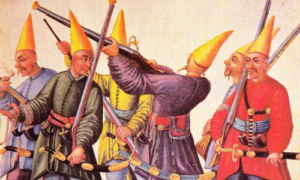
In the meantime, the Hungarian Palatine and his army had come into the Szerémség (Sirmium) Area but didn`t dare to engage in battle with the army of the Sultan. Hearing of this, the Sultan demanded Oláh Balázs surrender the castle on 25 August. The Captain has refused it. Then, he could face the next assault only with his remaining 400 warriors and he managed to beat the Janissaries out of the castle again on 26 August. The next day, the Turks had a mine explode under the Kőles tower, breaking a long and huge breach.

The coming assault could have not been stopped, Captain Oláh got wounded and he withdrew with his surviving 72, mostly injured soldiers into the inner palace, along with the remaining Serbian inhabitants. This last Turk attack was beaten back only by the heroism of Káldi Miklós who cut off the head of a Turkish Bey. You can read more about Káldi here:
https://www.hungarianottomanwars.com/1541-1699/an-old-warriors-challenge-to-a-duel-1555/
Oláh, running out of gunpowder and food, had to agree to negotiate. Suleiman offered him that he could leave unharmed.
He received the heroic captain and his soldiers on 29 August and offered them to join the Sultan’s army. Having received their denial, the Turks had them transported to the opposite bank of the Danube. There, the soldiers of the Bosnian Bey Báli attacked them and slaughtered almost every one of them. The sultan had the Serbian inhabitants re-settled in Istanbul. In the picture: Sultan Suleiman was executing captives of war at Nándorfehérvár in 1521:

All in all, the heroic defenders of these castles were able to prevent Sultan Suleiman from continuing his campaign against Hungary during that year. Their blood gained precious time. The next Ottoman onslaught was repelled in 1523 in the Battle of Szávaszentdemeter. You can read about that battle here:
https://www.hungarianottomanwars.com/1490-1541/the-battle-of-szavaszentdemeter-1523/
Source: Szibler Gábor and Bánlaky
Dear Readers, I can only make this content available through small donations or by selling my books or T-shirts.
If you like my writings, please feel free to support me with a coffee here:
You can check out my books on Amazon or Draft2Digital, they are available in hardcover, paperback, or ebook:
https://www.amazon.com/dp/198020490X
or at https://books2read.com/b/boYd81


My work can also be followed and supported on Patreon: Become a Patron!http://Become a Patron!


https://hungarianottomanwars.myspreadshop.com/all


